Journey from Native Tribes to Pilgrims’ Tables
Pumpkins, native to North America, have been cultivated by Native American tribes for thousands of years. They hold a significant place in their traditional practices and cuisines, deeply integrated into their culture. Certain Native American groups, such as the Navajo, Hopi, and Pueblo, have even established Pumpkin Clans and hold traditional Pumpkin Flower Dances.
Upon their arrival in America, the Pilgrims and other early European settlers were introduced to pumpkins by the Native Americans. Pumpkins became an essential part of the settlers’ diets because of their versatility, long shelf life, and ease of cultivation. The tradition of pumpkin pie can be traced back to these early settlers, who created a version by hollowing out a pumpkin, filling it with milk, honey, and spices, and baking it in hot ashes.
Today, pumpkin pie remains a beloved dessert served during Thanksgiving. Pumpkin puree is a common ingredient in many Thanksgiving recipes, adding to the holiday’s distinct flavours.
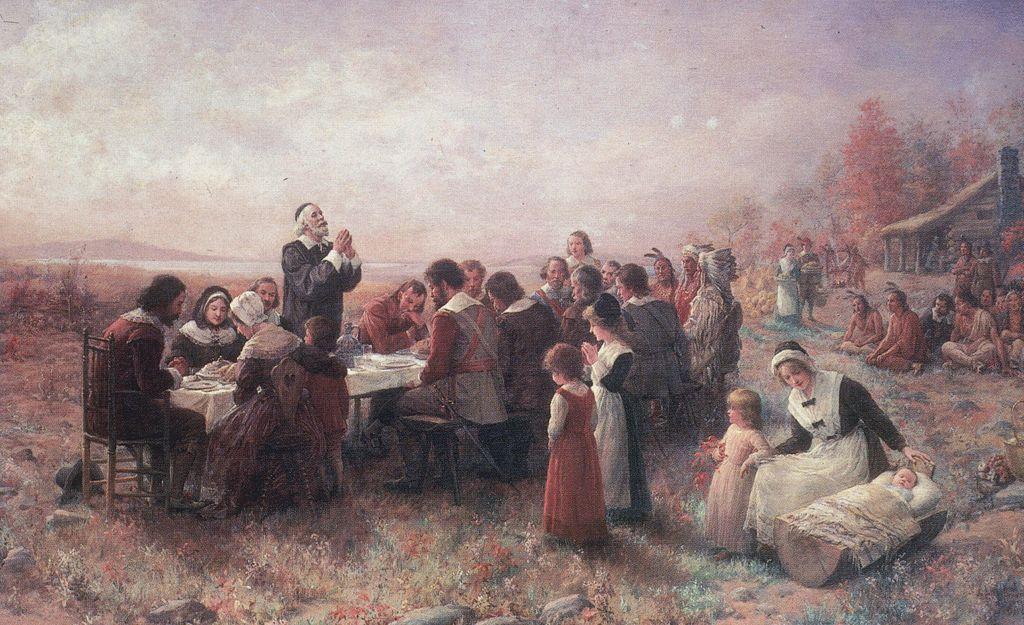
First Thanksgiving_pilgrims and native Americans(1621); Source: jstor.org
PUMPKIN HEADS AND EMPTY MINDS
Italian painter Giuseppe Arcimboldo, in his famous vegetable compilation portraits, equated pumpkins with a man’s mental capacities or the lack thereof. In his late 16th-century paintings, titled Autumn (1573) and Vertumnus-Rudlof II (1591), Arcimboldo depicted an assortment of garden produce to form the outline and features of a man’s head and torso. In Autumn, the man has a pumpkin head, and in Vertumnus-Rudlof II, a pumpkin heart or chest. The artist’s strategic placement of the pumpkins suggests his commentary on his subject’s perceived mental emptiness.
The portraits confounded and delighted Arcimboldo’s contemporaries, as well as later generations of scholars. Interpretations of these vegetable portraits have ranged from allegories of the universe to “serious jokes” about the Habsburg monarchy.
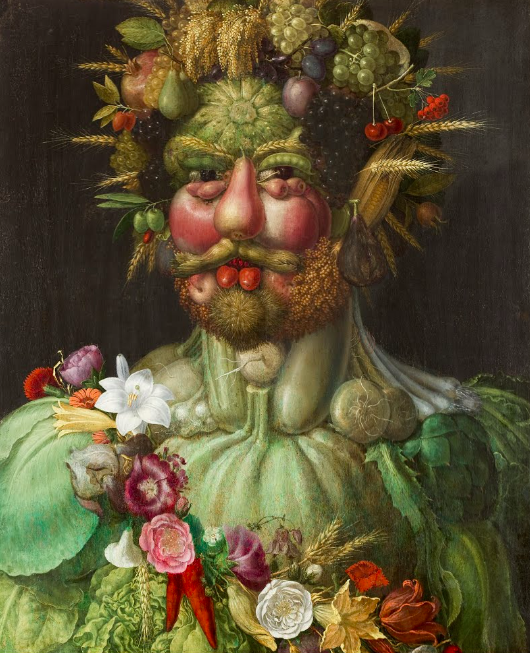
Vertumnus-Rudlof II (1591); Source: wikimedia
HARVEST OF DESIRES
In the 16th century, Dutch artists Pieter Aertsen and Joachim Beuckelaer such as often depicted plump peasant women surrounded by a bountiful harvest in their paintings. These women were often shown with an abundance of fruits and vegetables, including pumpkins and squashes, spilling out from giant baskets. The scenes also hinted at sexual allure, with men lurking in the background and gazing at the female peddlers and their products. The choice of rustic peasant women effectively conveyed themes of sexuality and unguarded lust, as they were believed to have a deeper connection with nature and were less constrained by social conventions.

Market Scene by Pieter Aersten (1591); Source: wikimedia
MAYAN LEGEND OF HERO TWINS, GODS, AND A PUMPKIN
In the ancient Mayan culture, pumpkins held great significance as symbols of life force and vitality. The Popol Vuh, a book documenting Mayan mythology, history, and traditions, tells the tale of the Hero Twins, Junajpu and Xb’alanke. These twins faced trials and battles against the Xibalba, the Lords of the Underworld, ultimately using a pumpkin to outsmart them and achieve victory.
In a ballgame challenge, Junajpu is decapitated by a giant bat, and his head is used as the ball. Xb’alanke cleverly uses a pumpkin to temporarily restore his brother’s head. The twins then deceive the Lords of Xibalba by turning a rabbit into the ball, allowing Xb’alanke to retrieve Junajpu’s true head and reattach it. The game concludes with the twins winning as Xb’alanke smashes the pumpkin-ball against the court wall, scattering seeds all around.
This ingenious use of the pumpkin not only helps the Hero Twins defeat the Lords of Xibalba but also symbolizes the victory of life over death. The scattering of seeds represents vital energy, the soul, or the seeds of life.
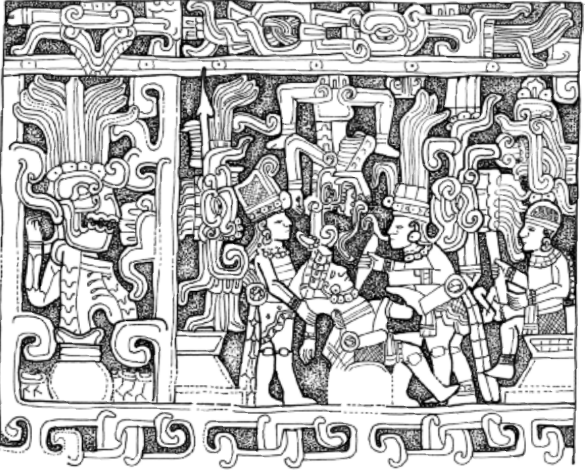
Sacrifice by decapitation, south ball game, El Tajín (Ladrón 2006: 83)
ORIGINS OF JACK-O-LANTERNS
The custom of carving pumpkins for Halloween originates from an Irish tale about Stingy Jack. Legend has it that Jack was denied entry into both heaven and hell upon his death. The devil, feeling sorry for him, gave Jack a burning coal to light his way, which he placed inside a hollowed-out turnip. Ever since, Jack’s spirit has been wandering the earth.
To ward off spirits like Stingy Jack, people in the British Isles began carving faces into turnips, potatoes, radishes, and beets. These carved vegetables would then have candles placed inside them, much like the pumpkin lanterns we associate with Halloween today. The belief was that these illuminated creations could keep evil at bay and bring light to the darkness.
When Irish and Scottish immigrants brought their Halloween traditions to America, they found that pumpkins were more abundant and easier to carve than turnips. Thus, pumpkins became the go-to choice for Jack-o’-lanterns. Harvested in the fall, pumpkins’ vibrant orange hue and round shape make them ideal symbols of autumn and popular holiday decorations.
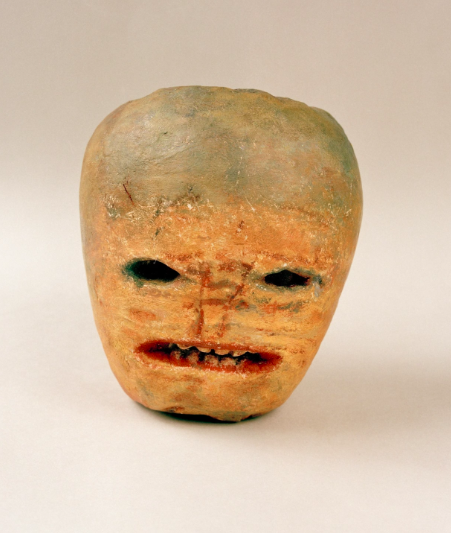
Irish turnip carving; Source: Smithsonianmag
THE GREAT PUMPKIN FLOOD OF 1786
In October of 1786, following an exceptionally rainy autumn, the Susquehanna River in Pennsylvania was hit by severe flooding. The floodwaters carried away numerous pumpkins from the fields lining the riverbanks. When the waters subsided, these pumpkins floated downstream, creating a surreal scene where the river was covered with thousands of bright orange pumpkins.
Click here for more info: YouTube
PUMPKINS IN FOLKLORE AND LITERATURE
In the classic tale of “Cinderella,” a pumpkin is transformed into a stunning carriage by the fairy godmother, enabling Cinderella to conquer her obstacles and attend the grand ball, altering her fate forever.
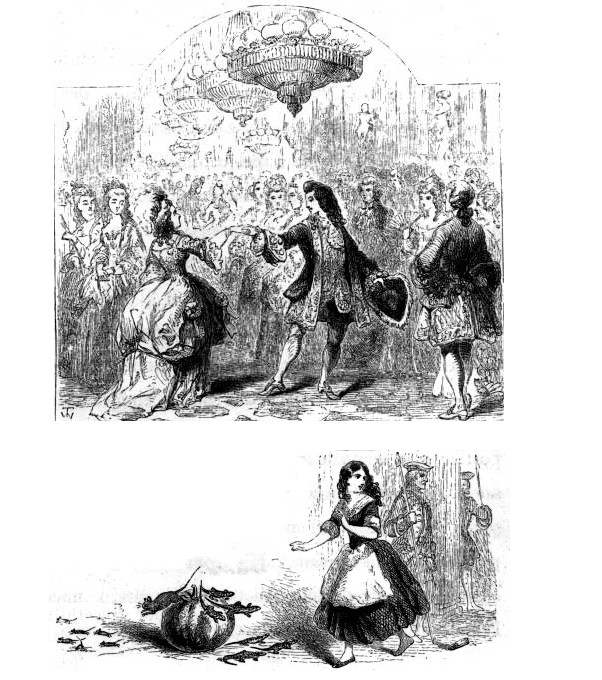
Carriage turn back to a pumpkin: source: Hewet’s household stories for little folks (1855)
A different take on pumpkins can be seen in Frank Baum’s “Oz” series with the character Jack Pumpkinhead. Jack, with a wooden body and a pumpkin head brought to life by the Powder of Life, is kind-hearted yet naive, often worried about his head decaying. He plays a vital role in assisting Tip in overthrowing the Scarecrow and helping Princess Ozma claim her rightful place as ruler of Oz.
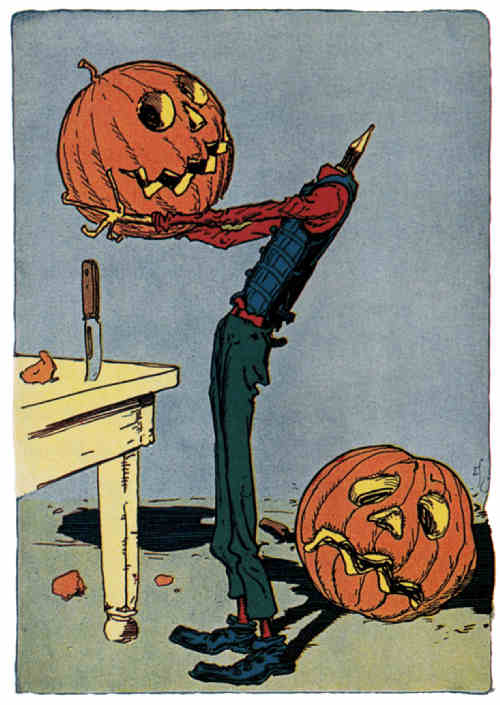
Jack the Pumpkinhead; source: project Gutenberg
The journey of a pumpkin, from a tiny seed in the soil to a delectable pie, is beautifully illustrated in William E. Barton’s early 20th-century poem “Story of Pumpkin Pie.” The poem’s message emphasizes the value of hard work and patience in farming and cooking, as well as the happiness that comes from sharing food with others.

Book: Story of pumpkin pie: source: project Gutenberg
POTENTIAL MEDICINAL BENEFITS OF PUMPKINS
Pumpkins are not just symbols in art, literature, and folklore; they offer significant scientific benefits. The ripe pumpkin pulp, seeds, powder, and peel are packed with fiber and essential minerals like zinc, phosphorus, magnesium, potassium, and selenium, crucial for overall body function. Additionally, pumpkins contain bioactive compounds that possess anti-inflammatory, antibacterial, anticarcinogenic, and antidiabetic properties. Ongoing research is exploring the potential health benefits of pumpkin seeds in managing conditions such as diabetes, heart issues, cancer, depression, worm infections, and lifestyle disorders. Moreover, pumpkins can also be advantageous for skincare. A recent Thai study revealed that the polysaccharides found in Japanese pumpkins are excellent for maintaining skin hydration. Incorporating these compounds into skincare products could offer a safe and effective solution for combating skin dryness and signs of aging.
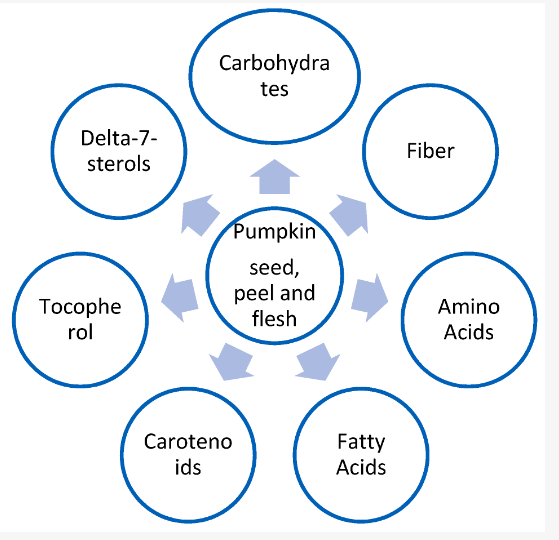
References
- Paris, H.S. Historical records, origins, and development of the edible cultivar groups ofCucurbita pepo (Cucurbitaceae). Econ Bot 43, 423–443 (1989). https://doi.org/10.1007/BF02935916
2. Ott, C., 2012. Pumpkin: The curious history of an American icon. University of Washington Press.
3. PATZÁN, D.M.G. and REGA, M.F., The Decapitation Ritual and the Ancient Maya Ballgame. From Archaeological Evidences to Sacred Stories.
4. Batool, M., Ranjha, M.M.A.N., Roobab, U., Manzoor, M.F., Farooq, U., Nadeem, H.R., Nadeem, M., Kanwal, R., AbdElgawad, H., Al Jaouni, S.K. and Selim, S., 2022. Nutritional value, phytochemical potential, and therapeutic benefits of pumpkin (Cucurbita sp.). Plants, 11(11), p.1394.
5. Devi, N.M., Prasad, R.V. and Sagarika, N., 2018. A review on health benefits and nutritional composition of pumpkin seeds. International journal of chemical studies, 6(3), pp.1154-1157.
6. Museum of food and culture
7. Project Gutenberg
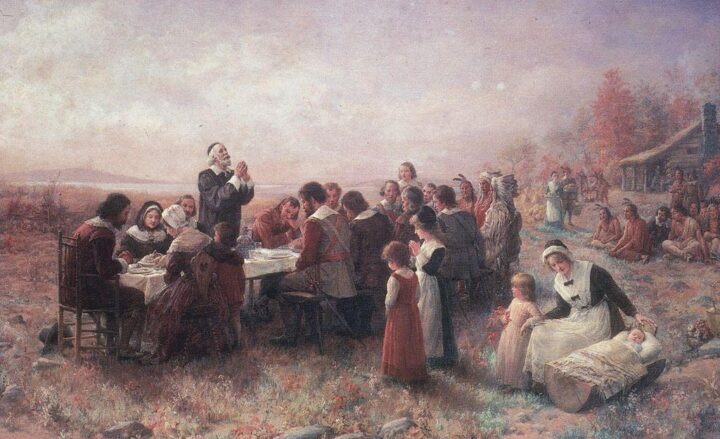
Leave a Reply